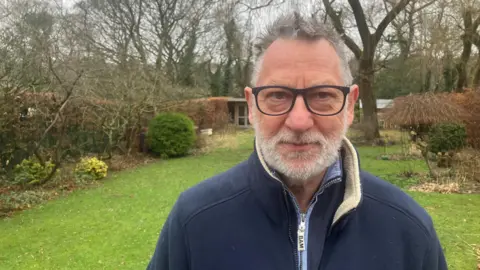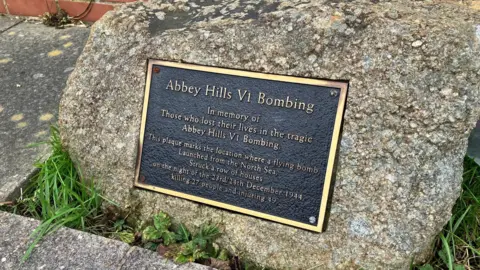'Doodlebug' bomb attack remembered 80 years on
 St Anne's Church, Tottington
St Anne's Church, TottingtonThe victims of a notorious flying bomb attack during World War Two have been remembered 80 years after they lost their lives.
Forty-two people died when the Nazis launched dozens of the V1 "Doodlebug" rockets at the Manchester area on Christmas Eve 1944.
The worst attack was on Abbey Hills Road in neighbouring Oldham, where a V1 landed on a row of terraced houses, killing 27 people and seriously injuring 49.
Although aimed at Manchester, not many of the famously inaccurate bombs landed in the city.
Forty-five rockets were launched that night, of which 31 reached the UK and only 15 landed in Greater Manchester.

The youngest victim was 18-month-old Malcolm Graham Hutton, who died in Abbey Hills Road.
Six people also died when a V1 landed on Chapel Street in Tottington, near Bury.
A remembrance garden was built at the site in Tottington, which came to be known as Whitehead Gardens, and there is a plaque to remember those who perished.
Another of the rockets hit Davenport Golf Club in Stockport, destroying two homes, creating an 18ft (5.5m) crater and killing one resident, while another person died in Worsley.


Frank Pleszak, 66, local historian and volunteer at the Avro Heritage Museum in Woodford, said the attack on the region was mostly for propaganda purposes.
"The bombing of Manchester and the area had largely stopped by 1944, they were launched as a way of demoralising the population," he said.
"They were launched off a Heinkel twin engine bomber off the Yorkshire coast near the Humber Estuary.
"They weren't accurate and were sent roughly in the area of Manchester. Very few landed in the area and Manchester itself wasn't actually hit."
He added: "It was awful, some died in the raid and some after the event."
 Getty
GettyThe V1 flying bombs, which were known as doodlebugs due to the distinctive sound they made in flight, were winged missiles powered by a jet engine and plummeted to the ground once their engines had stopped leaving an eerie silence for terrified people on the ground.
Britain's first V1 attacks took place in June 1944, shortly after D-Day, when Allied armies had invaded German-occupied France.
Nazi propaganda hailed the weapons as "wonder weapons" - "wundawaffe" - that might turn the tide of the war.
Tens of thousands of slave labourers from the Mittelbau-Dora concentration camp lost their lives building the tunnels where the weapons were made.
Listen to the best of BBC Radio Manchester on Sounds and follow BBC Manchester on Facebook, X, and Instagram. You can also send story ideas to [email protected] and via Whatsapp to 0808 100 2230.
